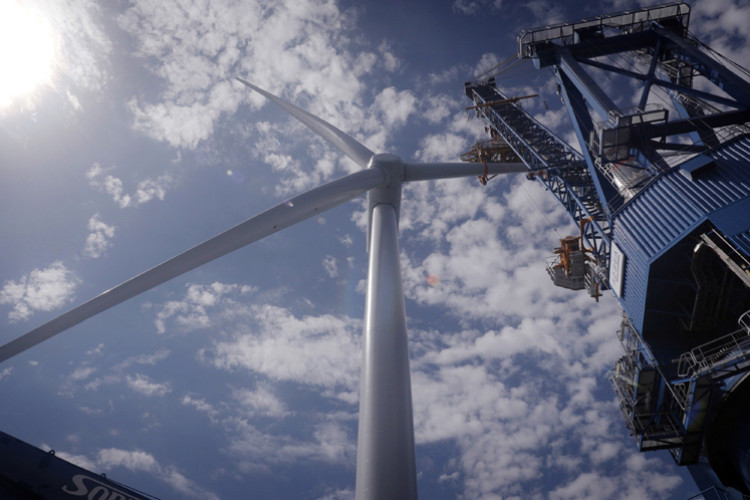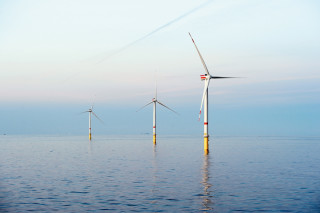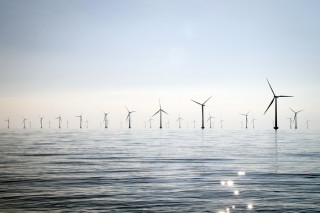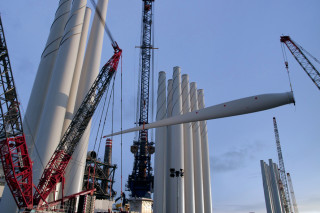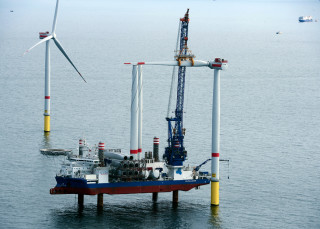The offshore wind industry may be young – it has only been going for around 15 years – but it has grown fast. It now employs more than 11,000 people and supplies 8.5% of all UK electricity. Under the terms of a new government ‘sector deal’ that output is set to rise exponentially until, by 2030, it supplies a third of all the UK’s electricity needs, boosting its output from 8GW to more than 30GW.
As Benj Sykes, co-chair of the Offshore Wind Industry Council (OWIC), says, the opportunities that this offers are not limited to specialist offshore contractors as there is plenty of work required to deliver and distribute this energy throughout the UK.
“We [the offshore wind industry] are one of the top four infrastructure projects in the UK with investment of more than £18bn between 2017 and 2021,” says Sykes, who is also country manager for Danish-owned Ørsted UK which is currently developing the world’s largest windfarm 50 miles off the coast of East Yorkshire at Hornsey.
“Ørsted alone is spending £1bn a year and the industry will be spending more than £40bn to achieve its target, boosting the workforce up to more than 27,000 – a third of them women. It’s a massive investment,” says Sykes.
That investment needs a strong supply chain, Sykes argues, and the industry is committed to boosting the UK share of the construction works from its present level of around 50% to 60% by 2030. The onshore works are a significant element of this, whether it is laying cable or constructing new substations and new operational bases. Balfour Beatty, for instance, is currently constructing substations for Hornsey 1 and Hornsey 2 while Ørsted has also commissioned an operations base to be built to accommodate 400 of its staff at Grimsby.
The expansion of the industry is imminent: the next competitive auction to procure new renewable power capacity takes place this month, when offshore wind, remote island wind and a range of other projects compete for Contracts for Difference (CfD). When the Department for Business, Energy and Industrial Strategy announced this in July 2018, it also said would hold further CfD auctions every two years, supported by a budget of £557m. According to Sykes, the result of the next auction will be known this autumn and the successful bidders will begin procurement soon after.
Contractors will also be able to plan securely for the future because more sites will be made available within the next seven months. The whole of the seabed in UK waters is owned by either the Crown Estate or Crown Estate Scotland, both of which will offer new sectors to lease in 2019, sufficient for between 7GW and 8GW, to make sure that there is a sustainable pipeline of new projects to be developed in the 2020s and 2030s.
There are already contractors working successfully with the offshore wind power industry. For example Smiths Brothers, the Yorkshire specialist in high-voltage power engineering, has a large division that specialises in connecting renewable power to the National Grid and has just signed an alliance with windfarm operator Vattenfall. The company deals with anything onshore that is connected with distribution, such as building new substations, reinforcing networks, and cabling.
National contractor J Murphy & Sons is already well-established in the industry. It is, for instance, the preferred supplier for design and cable work for Triton Knoll, a windfarm owned by German firm Innogy, 32km off the Lincolnshire coast. It has a planned installed capacity of 860MW, enough to supply 800,000 homes.
Murphy will install 60km of underground cable and carry out what it claims is the largest number of horizontal directional drills ever undertaken on a single infrastructure project. Murphy will also design and install the project’s critical onshore cable circuits, stretching from the point of landfall at Anderby Creek, near Skegness, to a new-build substation at Bicker Fen.
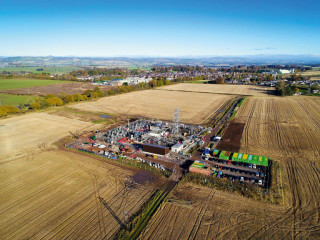
Both companies are clear that major works will be required to bring the distribution network up to the required standard.
“The network as it is won’t be able to cope with the demand for infrastructure that will come from the number of windfarms being planned,” predicts Dave Ogden, Smiths Brothers’ commercial director. “There will be a big influx of work onshore that will be required to facilitate the offshore capacity. What’s happening offshore will have a massive impact onshore.”

At present renewables form 50% of Smith Brothers’ business, with offshore accounting for up to 10% of that, though Ogden reckons this will increase as a result of its relationships with Vattenfall and with Scottish Power.
Meanwhile, Murphy’s strategy director, John Kinirons, sees the sector deal as vital for planning:

“It’s a welcome announcement …. one that helps contractors like ourselves have some visibility of the opportunities that may come down the road,” he comments. “Infrastructure is essential and making sure we have the technology, skills, capabilities and people ready to go to connect these kinds of projects into the network is vital. Some of these connections are lengthy, and can involve numerous engineering challenges that need to be carefully managed.”
The industry itself is aware that it needs to strengthen its supply chain – and that includes the onshore construction element – and so, this summer, it is launching the Offshore Wind Growth Partnership. This will invest up to £100m over the next 10 years to support UK companies in growing their business in the global offshore wind market and to establish a new initiative to develop skills for the sector.
The partnership is based on similar initiatives in the aerospace and automotive industries to equip UK businesses so they can compete successfully.
“If there are players in the construction sector who want to invest in better systems and productivity so they can win contracts, then this is something to look out for,” says Sykes. “We’re already working with the likes of Balfours and Morrison Utility Services (MUS) to bring these big projects into being.”
.png)
The industry will also need skilled people at every level, he says, with a construction background. “It’s a really diverse set of skills that we’re looking for. At Hornsey, for instance, Ørsted is recruiting civil and electrical engineers and we always need top quality project managers because these are large and complex projects and we have a track record, as an industry, of delivering on time and under budget,” he argues.
“We also have our own team of operations and maintenance staff at our operations hub in Grimsby, so there are a lot of transferrable skills from the construction industry that we are already tapping into and there can only be more in the future.”
And the prospects for works overseas are also bright, as the industry has set ambitious targets. It is committed to scaling up exports five-fold from where they are today – around £0.5bn – to more than £2.5bn by 2030. Sykes points out that the offshore industry is growing globally, with the UK currently the world leader in this technology. Germany, the Netherlands and Denmark have all begun investing and France is beginning to be interested. Outside Europe, the US and Taiwan have started to invest and the OWIC expects to see offshore wind developments in Japan and Taiwan.
For the offshore wind industry, the next few months are crucial if it is to achieve all these ambitions. Several milestones are hoving into view over the next few months: the result of the Contracts for Difference later this summer; the formation of the Offshore Wind Growth Partnership, currently advertising for a non-executive chair and two non-executive directors; and then the new sectors of seabed being put up to be leased by the Crown Estate and Crown Estate Scotland.
Yet, if all goes to plan, there should be at least some certainty over the future workload that might even mitigate the disappointments in the past months as major nuclear projects – namely Wylfa in North Wales and Moorside in Cumbria – seem to have stalled.
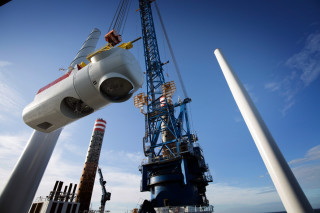
Offshore wind sector deal
This new deal with the offshore wind power industry might be the first sector deal for a renewable energy technology but it is far from being the only one of its kind.
There are other sector deals for industries including aerospace, artificial intelligence, automotive, construction, creative industries, life sciences, nuclear and rail.
Sector deals are an integral part of the government’s industrial strategy and are based on the premise that “partnerships between the government and industry on sector-specific issues can create significant opportunities to boost productivity, employment, innovation and skills”. It cites the Auto Council and the Office for Life Sciences as two bodies that prove these partnerships can work.
Offshore wind power ticks many other boxes though. It is not only low carbon – a big consideration in the light of climate change – but it is also cheap. The costs of production halved during the first 15 years of this century so that now this form of energy is cheaper than nuclear, gas or coal.
It also has the advantage, according to Offshore Wind Industry Council co-chair Benj Sykes, that it is not based in London or the South East but can create high-value jobs throughout Britain – and in the places of greatest need.
Just weeks after the sector deal was signed, the House of Lords select committee on regenerating seaside towns published its report, The future of seaside towns.
Committee chairman Lord Bassam of Brighton, said: “For too long, seaside towns have been neglected. They suffer from issues rooted in the decline of their core industries, most notably domestic tourism, but also in fishing, shipbuilding and port activity, and from their location at the ‘end of the line’.”
The sector deal, with its target of at least 27,000 jobs by 2030 can offer alternative employment.
There are now eight large offshore wind projects currently under construction in locations such as Great Yarmouth and Lowestoft in East Anglia, Mostyn in North Wales, Grimsby and Barrow-in-Furness. These have the potential to become hubs of activity for construction and the operations and maintenance that support the growing number of offshore windfarms.
Offshore wind statistics
• In 2017 offshore wind supplied 6.2% of the UK power needs and this is predicted to rise to over 10% by 2020. Renewables overall provide over 30% of the UK’s power needs. (source: Department for Business, Energy & Industrial Strategy)
• The UK’s offshore wind fleet generates enough electricity to meet the annual power needs of over seven million homes. (source: RenewableUK)
• There are now 37 offshore windfarms operating in the UK, comprising nearly 2,000 turbines, totalling 7,899MW. Three further offshore windfarms are under construction amounting to 2,520MW. The pipeline of projects consists of:
• 20 windfarms (18,304MW) with planning permission or in the consenting process.
• 13 sites (10,425MW) in development, but which have yet to submit planning applications.
• The first offshore wind project in the UK (two turbines totalling 4MW) went operational in 2000.
• It took 19 years to build Britain’s first 5GW of wind capacity but only two years to build the last 5GW.
• In 2017, the industry installed a record 2,121MW with an average turbine size of 5.8MW.
This article was first published in the May 2019 issue of The Construction Index magazine
UK readers can have their own copy of the magazine, in real paper, posted through their letterbox each month by taking out an annual subscription for just £50 a year. Click for details.
Got a story? Email news@theconstructionindex.co.uk

